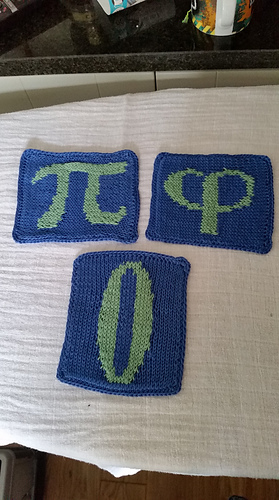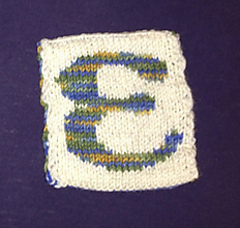patterns >  Lina Wolf's Ravelry Store
Lina Wolf's Ravelry Store
> Mathematical Underdogs Coffee Costers






Mathematical Underdogs Coffee Costers
Pattern contains 4 Coffee Coasters with underestimated Mathematical Numbers.
Now featuring 2 Bonus Coasters with e and sqrt(-1).
Pi π:
Even though to us Matematitions it seems to be unbelievable at times, the number π is not as widely known as we would like. There are still engineers, doctors and other professionals who just think π is about 3 (or 2.7 ;-))
And even people who can tell you many digits of π often do not know all the other uses of π. You can find π where there are no circles at all. See here: Wikipedia Pi - uses
Phi φ:
In mathematics, two quantities are in the golden ratio if their ratio is the same as the ratio of their sum to the larger of the two quantities. The figure on the right illustrates the geometric relationship, where the Greek letter phi (\varphi) represents the golden ratio.
What is little known is, that the golden ratio is very present not only in Mathematics and art but in Biology, Music, Book Design, …
Also you will find even fewer ppl for phi to know 3 digits then for pi.
More Info: Golden Ratio.
Epsilon ε:
A positive number tending toward but never reaching Zero. Many proofs contain something like : For all ε, where ε > 0, …
The usage of ε in that context is so well known with Mathematicians, that a common Math joke is: For all ε < 0 … (less then)
This number is as small as you can get without reaching 0 or below. It has a very smal absolute value, still a great value for analysis.
More Info:(ε, δ)-definition of limit
Zero 0
The number 0, having no value at all still has a great value in Mathematics. Never underestimate the 0. Expecially when appearing in Division or Exponates it can cause you a lot of trouble. In many contexts the 0 is a special case, never to be underestimated.
More Info: Zero in Mathematics
The Parable of the lost Epsilon
Have you wondered, why Epsilon is on another picutre then the other 5 coasters? This happened as follows: I had finally finished my 6th coaster. I put them all on my bed to take a picture. I made a careless move and both epsilon and phi fell behind my bed. My mother was able using a wire to fish phi out. But Epsilon is lost ever since.
The parable of the lost Epsilon:
“Or suppose a woman has six mathematical term coasters and loses one. Doesn’t she light a lamp, sweep the house and search carefully until she finds it? And when she finds it, she calls her friends and neighbors together and says, ‘Rejoice with me; I have found my lost Epsilon.’ In the same way, I tell you, there is rejoicing in the presence of the angels of God over one sinner who repents.”
However, Epsilon stays lost, no party. So what does it mean to Mathematics that Epsilon is lost. Why do we need it at all? Epsilon is used to prove facts what happens close to a border. For example a division through zero is not defined. We don’t know what 2/0 is. It is not Zero, it is nothing. But we can calculate, what is 2/0.1=20 2/0.01 = 200 … and we can also see what happens on the other side of number 0: 2/-0.1 = -20 2/-0.01 = -200 … So we can get a good feeling of what is happening close to 2/0. To represent the number that is getting closer and closer to 0 we commonly use the variable Epsilon, ε. On the other side just use -ε. So if we had no concept of ε some facts would be impossible to prove.
Read more here: http://en.wikipedia.org/wiki/(%CE%B5,_%CE%B4)-definition_…
2129 projects
stashed
1238 times
2884 projects
stashed
1240 times
- First published: March 2014
- Page created: March 10, 2014
- Last updated: October 21, 2021 …
- visits in the last 24 hours
- visitors right now




